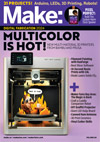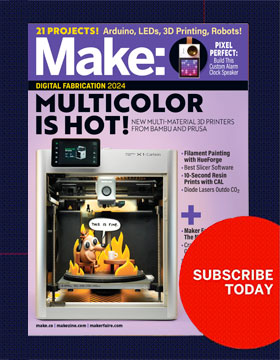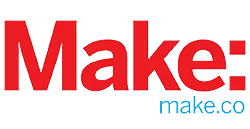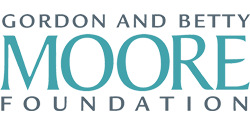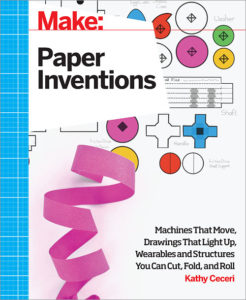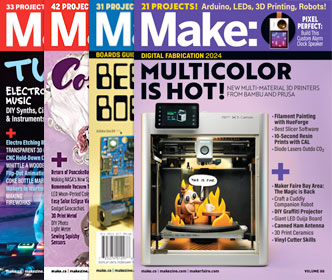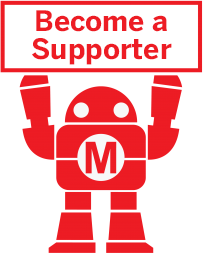Self-Folding Paper Models
Maker Camp is funded in part by the Gordon and Betty Moore Foundation and the generous support of the Members of Make: Community.

TO COMPLETE

WHAT WILL YOU MAKE?

WHAT WILL YOU NEED?
- Cardstock or construction paper
- Shrinkable polystyrene sheets (sold as Shrinky Dinks in art stores; you can also use recycled clear plastic containers marked with recycling symbol #6)
- Computer printer or copier (optional)
- Glue stick
- Scrap paper
- Black permanent markers
- Heat gun (available in craft stores) or toaster oven
- Long, narrow piece of thick cardboard (solid, not corrugated) to use like a spatula in the toaster oven (optional)
STEP 1
Choose a shape you’d like to build. For each shape, there’s a template for the inside paper layer, the outside paper layer, and the plastic layer in the middle. Copy each template by hand or with a printer. (You can find Shrinky Dinks sheets made for printers, but other kinds also work. Just be careful not to rub the printer ink off by accident.)
STEP 2
Cut around the image you copied onto the plastic. You don’t need to cut along the exact lines at this point. Do the same with the paper images. Cut out each side and apply glue:
STEP 3
Take the outside paper net and separate all the sides by cutting along each edge. Take one piece and place it on the scrap paper with the printed side facing down. Use the glue stick to coat the entire back of the piece with glue. Take the plastic and place it so the printed side is facing up. Attach the glue paper side over its position on the plastic. Do the same with all the other sides.
STEP 4
Turn the plastic over. Cut out all the sides of the inside paper image. Cut away the thick black lines. Glue the sides just like before, being sure that the paper pieces don’t cover the lines on the plastic.
STEP 5
Take the black marker and color over the thick lines where they are exposed. Black absorbs heat, so the black edges should start to shrink before the rest of the plastic.
STEP 6
If you have a heat gun, place the paper model with the inside facing up on a heatproof surface. Turn the heat gun on and blow the hot air on the paper model for a few seconds. Aim for the black lines where you want the model to bend. You should see the sides begin to fold up. Stop as soon as the edges meet. If you wait too long, the sides will start to shrink too.
STEP 7
If you are using a toaster oven, pre-heat it to around 275-300 degrees Fahrenheit. (This is cooler than for regular shrinkable plastic projects.) Place the paper model, inner side facing up, on one end of the thick piece of cardboard. You will hold the cardboard “spatula” while the model is heating up, so make sure it’s long enough to keep from burning your fingers.
STEP 8
Open the toaster oven door and leave it open. Slide the cardboard holding the paper model onto the rack inside while keeping a grip on the other end. Within a few seconds the sides should start to fold up. If it stops before closing up all the way, pull the model out to make sure the paper isn’t starting to burn. If it looks OK, put the model back in the oven for another couple of seconds until the model has closed up as much as it is going to:
WHAT'S NEXT?
In theory, any paper model that uses valley folds can be made with this self-folding technique. Just remember that the more sides—and folds—you add to a model, the harder it is for the model to fold itself up.
It is possible to use both valley and mountain folds in one self-folding paper model by cutting larger and smaller openings in the paper, depending on which direction you want that edge to fold. You may have to turn the model over halfway while heating it to make sure both sides of the paper shrink up correctly. (Let the model cool down in between to avoid burning the paper.)
You can also experiment with controlling how far the joint bends by changing the width of the opening in the paper. The amount of bend is known as the angle, and it can be measured with a math tool called a protractor. See if you can figure out how wide to make the opening to get a bend of 45 degrees or 30 degrees by measuring the finished product with a protractor. (You can find one where you buy school supplies.)
Take notes as you try different versions. That information may help you build more complicated self-folding models!
Please Note
Your safety is your own responsibility, including proper use of equipment and safety gear, and determining whether you have adequate skill and experience. Power tools, electricity, and other resources used for these projects are dangerous, unless used properly and with adequate precautions, including safety gear and adult supervision. Some illustrative photos do not depict safety precautions or equipment, in order to show the project steps more clearly. Use of the instructions and suggestions found in Maker Camp is at your own risk. Make Community, LLC, disclaims all responsibility for any resulting damage, injury, or expense.
ALL DONE? SHARE IT!
Share pictures and videos of your cool build! Be sure to use #maketogether or #makercamp
POST YOUR PROJECTSKits and Books From Maker Shed
Make: produces a variety of great products and helpful project tutorials to enhance your making experience.

